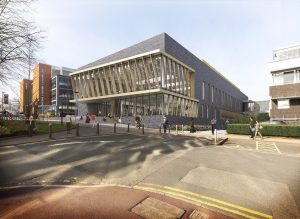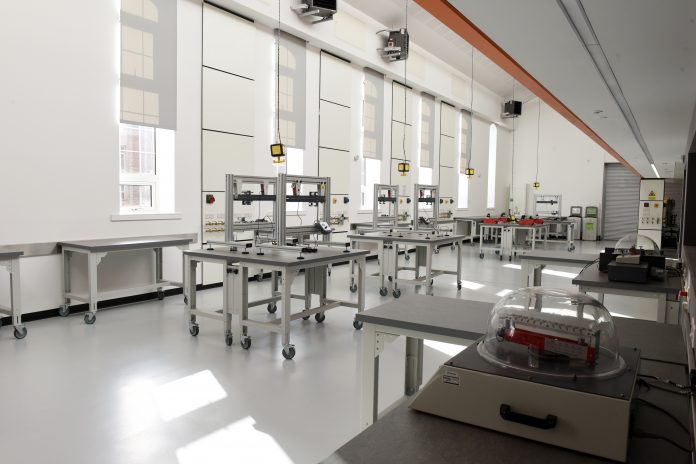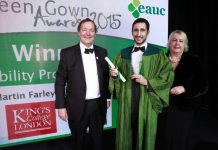Single discipline teaching labs can often be under used – typically for just 24 weeks per year. Ian Tidmarsh explains how new larger teaching labs at the University of Birmingham aim to provide more flexibility, higher utilisation and thus deliver better value for money.
STEM student numbers are on the rise and disciplines such as chemistry and biology require access to teaching labs to deliver taught practical elements. Following government commissioned reports on efficiency in higher education, attention at the University of Birmingham is focusing on how improved utilisation of teaching laboratory spaces can deliver better value for money.
Single discipline labs are expensive to maintain and upgrade
Traditionally, individual disciplines would have maintained teaching labs highly tailored towards their own needs and often for their exclusive use. A limited user base could result in low utilisation; this can be a particular issue for labs used solely for undergraduate teaching which could typically run for just 24 weeks of the year.
Laboratory spaces are the most expensive type of space for HEIs to maintain with costs ranging from high utility bills to the maintenance of high specification M&E (mechanical and electrical) services. The recurrent maintenance and the capital funds required to upgrade labs at the end of their useful life can be very high and this is multiplied by the number of facilities.
Technical staff are key to ensuring that lab classes operate. Technical duties are broad and can include preparing labs, providing in-class assistance and equipment maintenance and repair. The allocation of technical staff to discipline-specific labs can lead to a number of issues including poor planning for succession and a lack of development opportunities.
The collaborative teaching laboratory will offer large and flexible spaces
The University of Birmingham is currently investing over £42m in new teaching facilities called the Collaborative Teaching Laboratory (CTL). While the primary focus is on enhancing practical teaching the project is also introducing better value for money efficiencies in both terms of infrastructure and staffing.
In a departure from discipline-specific labs, the facility will feature large and flexible spaces that lend themselves to a number of disciplines and additional activities such as community outreach.
 In a lab environment, utilisation and value for money can be inextricably linked. The CTL has been designed to comprise the minimum number of different ‘types’ of lab space to reduce redundancy and to ensure that spaces are highly utilised with an aspirational utilisation rate of 70%. The larger sized spaces can also lead to better use of academic staff time whereby the need to ‘repeat teach’ due to capacity restrictions is reduced.
In a lab environment, utilisation and value for money can be inextricably linked. The CTL has been designed to comprise the minimum number of different ‘types’ of lab space to reduce redundancy and to ensure that spaces are highly utilised with an aspirational utilisation rate of 70%. The larger sized spaces can also lead to better use of academic staff time whereby the need to ‘repeat teach’ due to capacity restrictions is reduced.
Wider experience and development opportunities for technical staff
Technical staff are provided with the opportunity to work across a greater number of disciplines which could broaden their skills, knowledge and experience while providing greater variety and role enrichment. The University is working closely with the National Centre for Technical Development and Modernisation to ensure that technical staff benefit fully from their toolkit (under development).
Freeing up lab time reveals further potential efficiencies
Work to enhance practical teaching has revealed a number of further potential efficiencies, such as:
- Pre-lab activities such as videos designed to illustrate the use of equipment can better prepare students for classes thus reducing the learning curve on entering the lab;
- Better prepared students take less time to complete class activities;
- Writing up class notes can be scheduled into more appropriate spaces.
About the collaborative teaching laboratory
With respect to value for money and efficiency, the overall aims are:
- Larger and more flexible lab spaces that can accommodate a wide range of activity;
- Higher utilisation (and thus value for money) achieved via an unrestricted user base (e.g. activity assessment is based on infrastructure and resource need as opposed to discipline);
- Improved technical staff flexibility, better succession planning and development opportunities.
The project is being delivered in two phases. Phase I, a refurbishment of space yielding 1,000 sq metres, was completed in September 2016 and is currently open for teaching. Phase II is due to be completed by 2019 and will deliver nearly 7,000 sq metres of space. Once the new build space is available it is anticipated that an equivalent volume of outdated lab space will be retired.
Look here for more information on the collaborative teaching laboratory.







